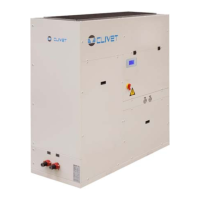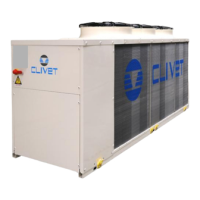24 WSAT-XIN 21-171 M0Q940G14-03
7.4 Refrigeration circuit
1. Check carefully the refrigerating circuit: the presence of oil stains can mean leakage caused by transportation, movements or other).
2. Verify that the refrigerating circuit is in pressure: Using the unit manometers, if present, or service manometers.
3. Make sure that all the service outlets are closed with proper caps; if caps are not present a leak of refrigerant can be possible.
4. Open the valves of the refrigerant circuit, if there are any.
7.5 Water circuit
1. Before realizing the unit connection make sure that the hydraulic system has been cleaned up and the cleaning water has been drained.
2. Check that the water circuit has been lled and pressurized.
3. Check that the shut-o valves in the circuit are in the “OPEN” position.
4. Check that there isn’t air in the circuit, if required, evacuate it using the air bleed valve placed in the system high points.
When using antifreeze solutions:
•
make sure the glycol percentage is suitable for the type of use envisaged
Weight of glycol (%) 10 20 30 40
Freezing temperature (°C) -3.9 -8.9 -15.6 -23.4
Safety temperature (°C) -1 -4 -10 -19
Modify the following parameters:
SetPoint Cool key Set
Menu SP Cool
Min Setpoint Cool Keys Esc + Set
Menu PAr Menu TR tr11
tr11<SetPoint Cool
Antifreeze alarm setpoint Keys Esc + Set
Menu PAr Menu AL AL51
Pump start setpoint for antifreeze Keys Esc + Set
Menu PAr Menu PI PI51
Antifreeze Heater Set Point Keys Esc + Set
Menu PAr Menu Hi Hi12
(PI51 = Hi12)>AL51
For example: AL51=0°C Hi12=+1°C PI51=+1°C
7.6 Electric Circuit
Verify that the unit is connected to the ground plant.
Check the conductors are tightened as: the vibrations caused by handling and transport might cause these to come loose.
Connect the unit by closing the sectioning device, but leave it on OFF.
Controllare i valori di tensione e frequenza di rete, che devono essere entro i limiti:
•
400/3/50 +/-10%
•
230/1/50 +/-10%
Check and adjust the phase balance as necessary: it must be lower than 2%
Example:
Working outside of these limits can cause irreversible damages and voids the warranty.

